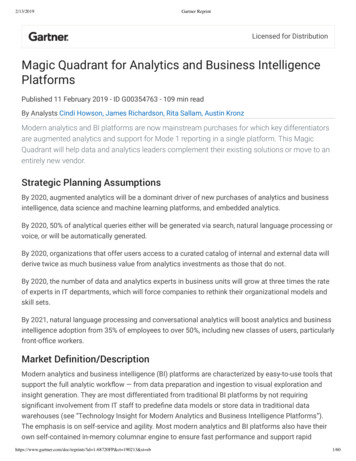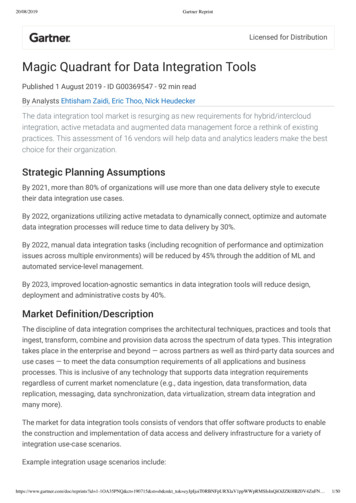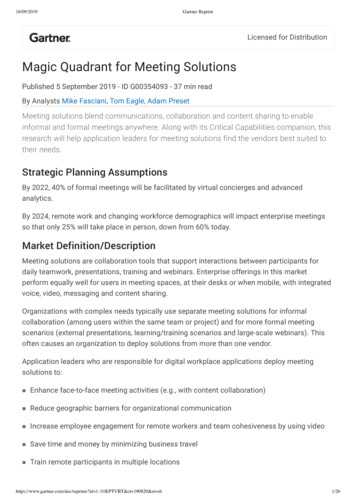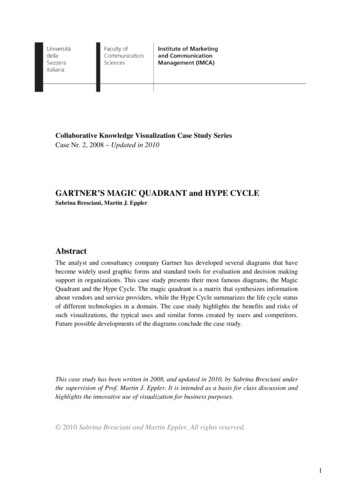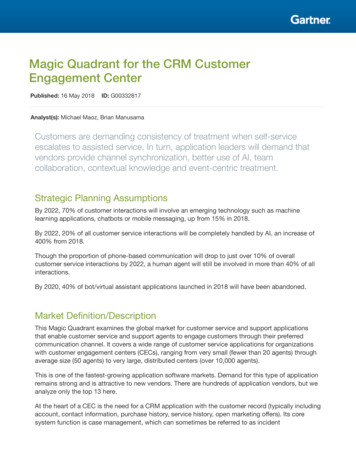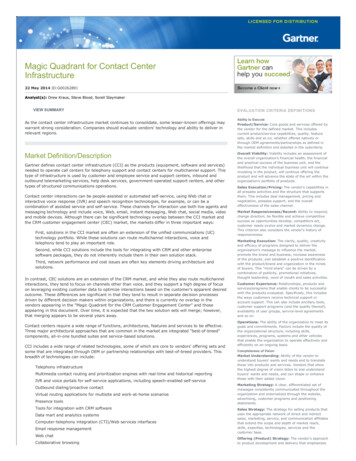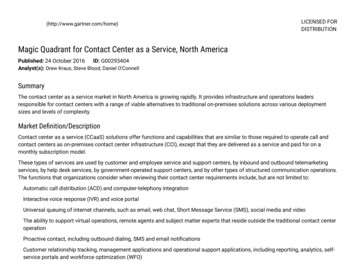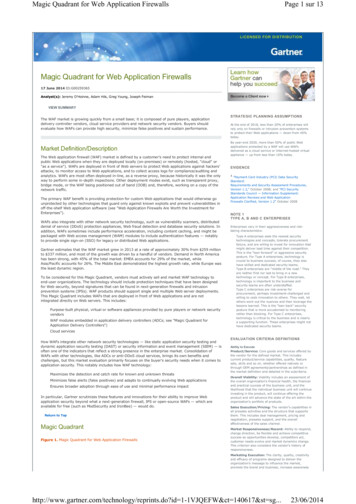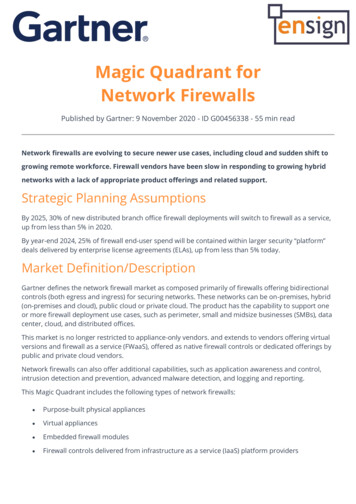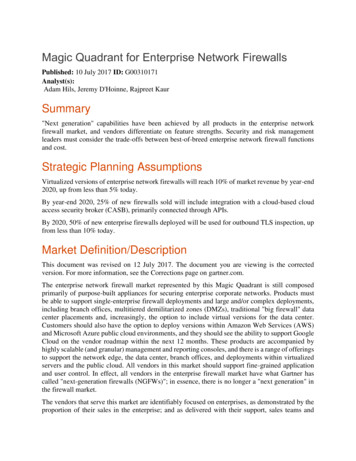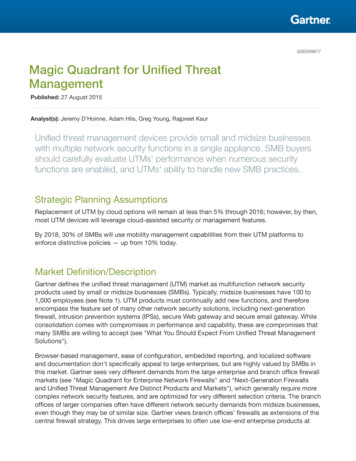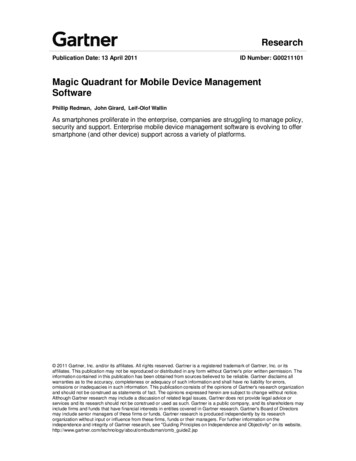
Transcription
ResearchPublication Date: 13 April 2011ID Number: G00211101Magic Quadrant for Mobile Device ManagementSoftwarePhillip Redman, John Girard, Leif-Olof WallinAs smartphones proliferate in the enterprise, companies are struggling to manage policy,security and support. Enterprise mobile device management software is evolving to offersmartphone (and other device) support across a variety of platforms. 2011 Gartner, Inc. and/or its affiliates. All rights reserved. Gartner is a registered trademark of Gartner, Inc. or itsaffiliates. This publication may not be reproduced or distributed in any form without Gartner's prior written permission. Theinformation contained in this publication has been obtained from sources believed to be reliable. Gartner disclaims allwarranties as to the accuracy, completeness or adequacy of such information and shall have no liability for errors,omissions or inadequacies in such information. This publication consists of the opinions of Gartner's res earch organizationand should not be construed as statements of fact. The opinions expressed herein are subject to change without notice.Although Gartner research may include a discussion of related legal issues, Gartner does not provide legal advice orservices and its research should not be construed or used as such. Gartner is a public company, and its shareholders mayinclude firms and funds that have financial interests in entities covered in Gartner research. Gartner's Board of Directorsmay include senior managers of these firms or funds. Gartner research is produced independently by its researchorganization without input or influence from these firms, funds or their managers. For further information on theindependence and integrity of Gartner research, see "Guiding Principles on Independence and Objectivity" on its budsman/omb guide2.jsp
WHAT YOU NEED TO KNOWAlthough some of the vendors and products have been around for a long time, mobile devicemanagement (MDM) is a nascent market, and the vendors' offerings have little consistency. Manycome from mobile messaging and security to support MDM, and, worldwide, there are more than60 companies in this space. Of these, 42 were deemed potential candidates for this MagicQuadrant (see Figure 1) and were sent questionnaires; 23 met Gartner's inclusion criteria.MAGIC QUADRANTFigure 1. Magic Quadrant for Mobile Device Management SoftwareMarket OverviewIntroductionAs smartphones and other mobile devices grow in popularity in enterprises, managementchallenges are beginning to arise — from the cost of the services associated with the devices, tothe security and policy that mobile devices should follow. Mobile devices such as smartphonesand tablets are increasing in power and memory, and, although they are not replacing PCs on afull-time basis, they are often used as primary communication devices. Also, the number ofvendors and platforms in the mobile device market continues to increase and add complexity.By 3Q10, there were more than 30 global smartphone vendors and more than 10 mobileoperating-system platforms, although the top four (Apple, Android, RIM and Symbian) controlPublication Date: 13 April 2011/ID Number: G00211101 2011 Gartner, Inc. and/or its Affiliates. All Rights Reserved.Page 2 of 25
89% of the total market. Most adopting companies that had previously standardized on a mobileplatform (for example, BlackBerry in North America and Symbian in Western Europe) now needto support multiple operating systems, and Apple and Android have become more popular.However, most organizations don't have anyone responsible for managing mobile devices.Although procurement may be found in finance or IT, there hasn't been any reason to bother withcellular phones after purchase. However, that's changing. Today, the smartphone is likely to bemanaged by the messaging group, which is responsible for the BlackBerry Exchange Server(BES), rather than by the entity responsible for managing computing hardware. Although manycompanies may have device management responsibilities, usually for hardware such as PCs orphones, current software doesn't really cover mobile devices, nor is IT staff trained to supporthandheld devices.Elements of MDMAlthough many companies are trying to solve a similar problem, it takes multiple types of mobilesoftware to address a full solution. A fully managed mobility solution cuts across standard MDMand telecom expense management and includes:Software Distribution — The ability to manage and support mobile applicationincluding deploy, install, update, delete or block.Policy Management — Development, control and operations of enterprise mobilepolicy.Inventory Management — Beyond basic inventory management, this includesprovisioning and support.Security Management — The enforcement of standard device security, authenticationand encryption.Service Management — Rating of telecom services.ConclusionThe MDM market is quickly evolving. The requirements and definitions are changing rapidly, andvendor offerings will evolve quickly and be even more capable and mature by next year. Highdemand is creating a frenzy of development, as well as hope. Although many of the successfulMDM providers have focused almost exclusively on mobility, during the next few years, thosemanaging PCs will also be investing and looking for opportunities in the MDM space. Mostvendors now offer on-premises or software-as-a-service (SaaS)-based tools, and more-maturemanaged service offerings will emerge during the next three years to drive growth in the industry.Some key things to keep in mind when assessing an MDM vendor are:Some of the device platforms will limit manageability, due to inherent manufacturerdesign — don't expect MDM solutions to address each platform the same way orsupport it the same way.Android support is still immature — it will be another year before Android is wellsupported by most MDM vendors.BlackBerry support is still important — not all MDM vendors support BES integration. Itis important that BlackBerry support continues, because, in many regions, it is still themost-supported enterprise device, even as other platforms take away market share.MDM tools won't beat the BES, but should be able to help manage and report onBlackBerry devices.Publication Date: 13 April 2011/ID Number: G00211101 2011 Gartner, Inc. and/or its Affiliates. All Rights Reserved.Page 3 of 25
Don't underestimate reporting — for some vendors, their reporting and businessintelligence (BI) tools are simple if they have them at all.Reporting on device status will be a critical component, and vendor capability to offerboth text and graphical reports, canned and customized, is critical.With the advent of new devices, the MDM market is growing quickly. If we assess pure MDMrevenue (excluding revenue for messaging, security, etc.) year-end 2010 is estimated at 150million, increasing at a compound annual growth rate (CAGR) of 15% to 20% during the nextthree years.Market Definition/DescriptionEnterprise MDM products and services help enterprises manage the transition to a morecomplex, mobile computing and communications environment by supporting security, service,software and inventory management across multiple operating-system platforms, primarily forhandheld devices such as smartphones and tablets. To meet Gartner's definition, MDM vendorsmust address at least three of the four "elements of MDM" set forth in the market overview andsupport MDM capabilities or features in mobile application platforms, with an emphasis on MDM.Rated vendors are generally expected to be able to respond competitively with respect to thefollowing features and functions.Inclusion and Exclusion CriteriaGartner is aware of more than 60 vendors that claim some level of play in MDM on a global basis.In most markets, even growth markets, large numbers of competing vendors with similar productsare cause for concern and indicate a need for competitive natural selection and consolidation.Inclusion CriteriaAfter due consideration, 23 vendors were selected to be included for ranking in this MagicQuadrant. The following criteria are necessary for inclusion:Support for enterprise-class (noncarrier), multiplatform support MDM: software or SaaS,with an emphasis on mobilitySpecific MDM product focus and feature set or a primary focus on MDM in anotherproduct set (messaging or security)Security management, with at least these features:Enforced passwordDevice wipeRemote lockAudit trail/logging"Jailbreak" detectionAt least mobile OS 3 platforms supportedPolicy/compliance managementSoftware distribution, with at least these capabilities supported:Application downloaderPublication Date: 13 April 2011/ID Number: G00211101 2011 Gartner, Inc. and/or its Affiliates. All Rights Reserved.Page 4 of 25
Application verificationApplication update supportApplication patch supportInventory management, with at least these capabilities supported:External memory blockingConfiguration change historyManaging at least 25,000 mobile linesFive referenceable accountsAt least 1 million in MDM-specific revenueExclusion CriteriaMDM companies not included in this Magic Quadrant might have been excluded for one or moreof these conditions:The company did not have a competitive product on the market for a sufficient amountof time during calendar year 2010 and the first quarter of 2011 to establish a visible,competitive position and track record.The company had a minimal apparent market share and low market inquiry interestamong Gartner clients.The company was invited to participate, but did not reply to an annual request forinformation and did not otherwise meet the inclusion criteria. Alternative means ofassessment, particularly client requests and competitive visibility, did not meet theinclusion criteria.The large number of vendors claiming presence in this market makes it impossible to includeevery company. Vendors were individually reviewed, discussed and selected by a team ofanalysts.AddedThis is the first Magic Quadrant published for this market, so all vendors referenced are new tothis research.DroppedThis is the first Magic Quadrant published for this market, so there is no history of vendorsdropped.Evaluation CriteriaAbility to ExecuteGartner analysts evaluate technology providers on the quality and efficacy of the processes,systems, methods or procedures that enable IT provider performance to be competitive, efficientand effective, and to positively affect revenue, retention and reputation (see Table 1). For MDM,this involved providing on-premises-based or SaaS capability with the required number offeatures to manage the software, security and inventory of a midsize or large (more than 1,000Publication Date: 13 April 2011/ID Number: G00211101 2011 Gartner, Inc. and/or its Affiliates. All Rights Reserved.Page 5 of 25
devices) organization. Although global scaling is important, there should be significant domesticor regional penetration at leading companies.Table 1. Ability to Execute Evaluation CriteriaEvaluation CriteriaWeightingProduct/ServicehighOverall Viability (Business Unit, Financial, Strategy,Organization)highSales Execution/PricingstandardMarket Responsiveness and Track RecordstandardMarketing ExecutionstandardCustomer ExperiencehighOperationsstandardSource: Gartner (April 2011)Completeness of VisionGartner analysts evaluate technology providers on their ability to convincingly articulate logicalstatements about current and future market direction, innovation, customer needs andcompetitive forces, as well as how they map to the Gartner position. Ultimately, technologyproviders are rated on their understanding of how market forces can be exploited to createopportunity for the provider. MDM providers should have a significant vision (see Table 2) on theevolving market, including software delivery methods, innovative and differentiated features,geographic expansion, as well as distribution and technology partnerships.Table 2. Completeness of Vision Evaluation CriteriaEvaluation CriteriaWeightingMarket UnderstandinghighMarketing StrategystandardSales Strategyno ratingOffering (Product) StrategyhighBusiness ModelstandardVertical/Industry Strategyno ratingInnovationhighGeographic StrategystandardSource: Gartner (April 2011)LeadersLeaders demonstrate balanced progress, effort and clout in all execution and vision categories. Ifthey do not dominate in sales, they are, at a minimum, the most critical competitive threat to theirpeers in open competition. A leading vendor is not a default choice for all buyers, and clients arewarned not to assume that they should buy only from the Leaders quadrant. To stay on the rightside of the chart, Leaders (and Visionaries) must offer features that remove significant roadblocksto the complex challenges enterprises face when attempting to treat mobile consumer devices asPublication Date: 13 April 2011/ID Number: G00211101 2011 Gartner, Inc. and/or its Affiliates. All Rights Reserved.Page 6 of 25
business tools. One example of a competitively disruptive activity might include delivering asandbox method to prevent data leakage between personal and business applications.ChallengersChallengers have attractive products that address the typical baseline needs for MDM withcompetitive visibility that is strong enough to demand attention in RFPs. Challengers may wincontracts by competing on a limited selection of functions or a limited selection of prospect buyersby industry, geography or other limiting factors, even if, on spec, their products have broadfunctions. They may be perceived as a threat by other vendors, but that threat will be primarilyfocused on a limited class of buyers, rather than the MDM market as a whole. Challengers areefficient and expedient choices for defined access problems.VisionariesVisionaries are able to demonstrate long-term strategies for MDM that point to the product andservice appro
Magic Quadrant for Mobile Device Management Software Phillip Redman, John Girard, Leif-Olof Wallin As smartphones proliferate in the enterprise, companies are struggling to manage policy, security and support. Enterprise mobile device management software is evolving to offer smartphone (and other device) support across a variety of platforms. Publication Date: 13 April 2011/ID Number .
